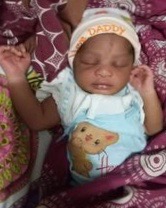There were years – many years, I’m convinced – when my parents did all of their Christmas shopping late on Christmas Eve, after the various vendors marked everything down. Our Christmas tree, for example, was one of the many things they got on clearance. It was always a sad, spindly, hopeless-looking thing when they brought it home. But my father managed to augment it with loose branches (probably free), which he stuck into the scrawny tree’s skinny trunk with the aid of an electric drill.
Another thing they no doubt bought on sale the year I was five or six was a black baby doll. I had asked (begged) Santa that year for a baby doll that drank and wet. On Christmas morning, when I opened the box with my name on the tag, I saw that my baby doll was chocolate brown.
“Santa said this one was the last in stock,” my mother said to me apologetically. I didn’t mind one bit. This baby doll was the cutest baby I had ever seen – with her pudgy cheeks, big bright eyes, sweet little smile, and plump body — I fell in love with her instantly. She became my own baby, and I became her forever mother.
At that time I’d never seen a real, live black baby in person. There were no black people in our small town in New Jersey nor in our larger world. I had, though, seen pictures of black children in children’s books, such as Little Black Sambo, and in articles about Africa in the grownups’ magazine National Geographic. Somehow I knew, looking at those photos in National Geographic, that I would live in Africa one day and it would play a large role in my life.
Memories of African babies I’ve held in my arms come flooding back to me now. One memory is particularly clear: On a train in Gabon, Central Africa, when I was in the Peace Corps serving as a Health and Nutrition volunteer there, I held a crying baby to try to soothe her. The baby’s young mother had her hands full with several other small rambunctious children while the father had stepped away for a while. I was sitting across from the family and asked the mother if I might hold the crying baby. She agreed.
When the father returned and didn’t at first see or hear his baby, he became alarmed. “Where’s the baby?!” he asked his wife in French, the lingua franca of Gabon. She pointed to me, holding the peacefully sleeping baby on my lap. He smiled at me, nodded at the baby and said to me, “She is my heart.”
After my Peace Corps service in Gabon, I went up to Mali, West Africa, where I lived and worked independently for three years in the fabled town of Segou, teaching Malian seamstresses, at their request, how to do patchwork quilting as an economic development project. When I first arrived in Segou in 1998, I was taken in by a large family and embraced by them and all of their many children.
Over the ensuing twenty-five years I’ve stayed in touch with this family – by letter with the patriarch, Makan, and more recently, via Facebook with Makan’s eldest son, Tidiani. Tidiani is now a responsible married man in his early thirties with two little children, the second of which is a newborn daughter to whom he’s giving my Malian name, Bani.

The tradition in Mali, as I came to understand it, is for foreigners who live there to take on Malian names and thereby become part of the overall Malian family — regardless of one’s age, skin color, ethnicity, nationality, or religion. I chose the name Bani because it’s pronounced like my actual first name and because it’s the name of the sister river to Mali’s mighty Niger.
Today, Christmas Day, Tidiani’s baby girl will be baptized in the Muslim tradition in Segou and given the name Bani, after me. I am not there to hold her, but I will always hold her in my heart. This honor, I feel, is the best Christmas gift I have ever received.
~ ~ ~ ~ ~ ~ ~ ~ ~ ~
For more true stories of my experiences in Africa, read How to Cook a Crocodile about my Peace Corps service in Gabon and How to Make an African Quilt about my three years in Segou, Mali. Both books are available from Amazon. See www.bonnieleeblack.com .
